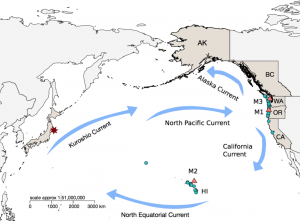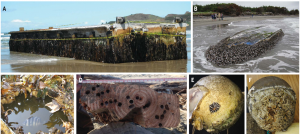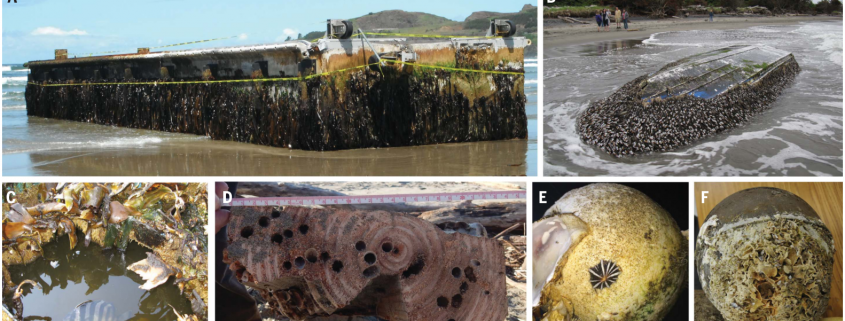By Grant Voirol, SRC intern
On March 11, 2011, the Tohoku coast of Honshu, Japan was struck by a tsunami reaching heights of 125 feet. The tsunami caused widespread destruction along the coast, casting boats, docks, and other objects into the western Pacific Ocean. Many of these items were homes for marine communities or were soon colonized, turning these floating debris into life support rafts traveling across the Pacific. Circulating through the ocean, these rafts eventually began to make landfall on the western coast of North America and Hawaii (Figure 1). In the five years following the arrival of the first transoceanic rafts in 2012, scientists conducted a massive scale collection of biodiversity levels supported by each of piece of debris found along the coasts of Alaska, British Columbia, Washington, Oregon, California, and Hawaii.

[Figure 1.] Major ocean currents in Northern Pacific Ocean showing the path of that marine debris took following the 2011 tsunami.
(Source: Carlton et al. 2017)
In order to sample the widest range possible, a large-scale coordination took place between the scientists conducting the study and local, state, and federal officials, as well as volunteer beach clean up groups to collect and photograph samples. In total, 634 pieces of Japanese debris were assessed for animal diversity. Scientists found 289 different species of animals on the debris, mostly consisting of invertebrates such as mollusks, crustaceans, worms, and other fouling organisms. Researchers even found fish native to coastal Japan living in the innards of fishing vessels (Figure 2). Fishing vessels and other larger debris such as docks were able to support much more diverse communities of organisms, while smaller debris such as crates or beams might only support few or one species. Additionally, multiple generations of the same species were found, indicating that these transoceanic rafts are suitable for reproduction to take place.

[Figure 2.] Examples of organisms found by researchers. (A) Dock found with high species richness, (B) Fishing vessel fouled with barnacles, (C) Japanese barred knifejaw fish found in a large fishing vessel, (D) wood beam bored by shipworms, (E) buoy with a single limpet, (F) buoy covered by bryozoans.
(Source: Carlton et al. 2017)
What this study shows is that man-made marine debris is a highly effective way to introduce nonnative species to coastal environments. While still present, very few rafts were composed mainly of natural materials such as wood. Mainly these rafts were consisted of metal, plastics, and fiberglass. These materials can survive for much longer periods in the ocean and therefore represent new ways for species to spread their geographic range. Additionally, the way that transoceanic rafts work increases their chances of spreading organisms from far off ecosystems. Firstly, they move slowly which lets the organisms that are along for the ride acclimatize to their new environment. Secondly, rafts can support large networks of reproducing organisms as opposed to planktonic juvenile organisms that need to grow to reproductive size. Finally, these rafts have an incredibly large geographic range, being able to make landfall at any point along the coast. Previous dispersal methods such as transport by ballast water confine nonnative organisms to harbors. What this means is that as we increase our use of non-biodegradable materials in coastal cities that can be swept away be storm, we are increasing the chances of species dispersal with consequences that we cannot fully predict.
Reference:
Carlton, J.T., Chapman, J.W., Geller, J.B., Miller, J.A., Carlton, D.A., McCuller, M.I., Treneman, N.C., Steves, B.P., Ruiz, G.M. “Tsunami-Driven Rafting: Transoceanic Species Dispersal and Implications for Marine Biogeography.” Science 357.6358 (2017): 1402–1406.






Leave a Reply
Want to join the discussion?Feel free to contribute!